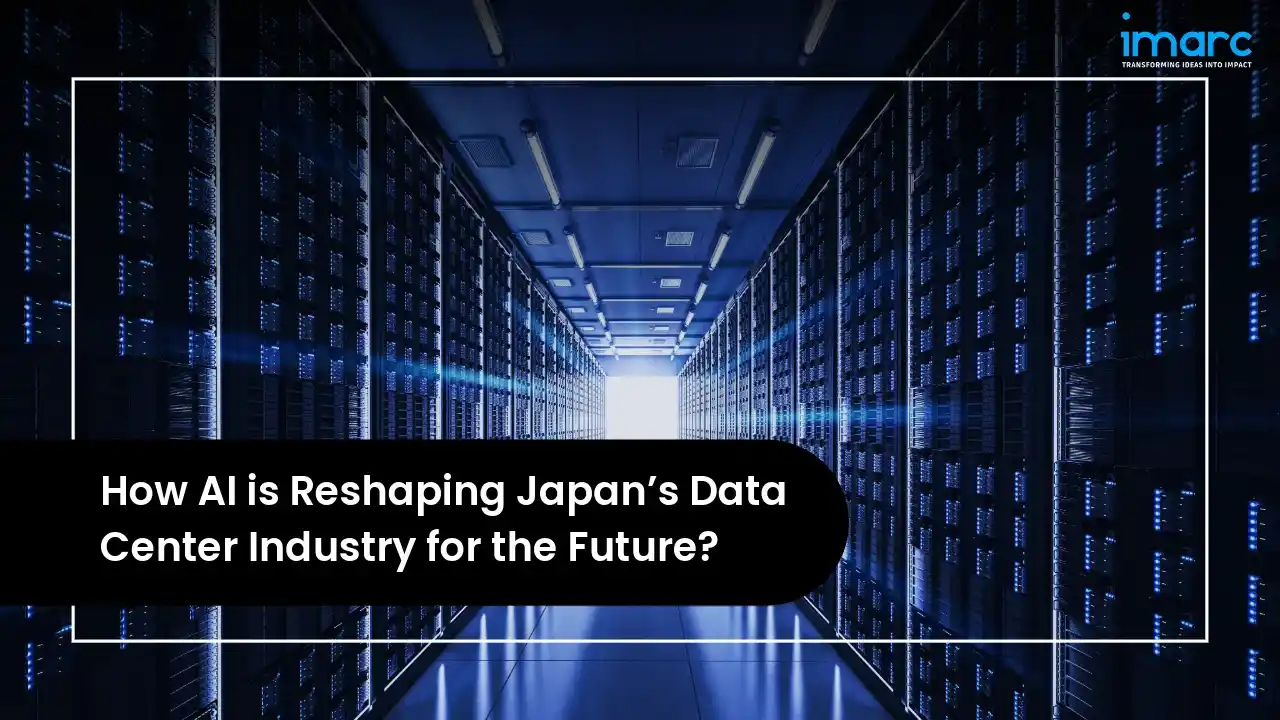How AI is Reshaping Japan’s Data Center Industry for the Future?

The data center sector in Japan is at the epicenter of a tech revolution, wherein artificial intelligence (AI) is fundamentally redefining how digital infrastructure manages, scales, and adapts. With the country progressing toward digital transformation in various industries, AI has been the force behind unprecedented innovation in the design, management, and optimization of data centers. This shift goes beyond basic automation to include intelligent systems that anticipate, adjust, and self-optimize in real-time, making Japan a world leader in intelligent infrastructure management.
Overview of the Japan Data Center Industry:
Japan's data center market has undergone significnat change in the last decade, emerging as one of Asia-Pacific's most advanced and technologically mature markets. The evolution of the industry mirrors the nation's broader commitment to digital transformation and its place as a regional technology hub. The Japan data center market size reached 1.37 GW in 2024. Looking forward, IMARC Group expects the market to reach 2.12 GW by 2033, exhibiting a growth rate (CAGR) of 4.99% during 2025-2033. Moreover, Japanese data centers not only support domestic businesses but also play strategic nodes in the international digital landscape to serve multinational companies, as well as emerging enterprises in various industries. The architecture of Japanese data centers reflects a distinctive combination of traditional engineering excellence and state-of-the-art technological advancement.

Explore in-depth findings for this market, Request Sample
Growth Drivers and Market Trends in Japan Data Center Market:
- The Japan data center market keeps growing fueled by a multitude of converging trends that mirror the nation's digital transformation journey. According to reports, in April 2025, SoftBank started building a $455.8 million, 700,000 sqm AI-centered data center in Tomakomai, Hokkaido, with an initial 50 MW in 2026 and possible expansion up to 1 GW. Furthermore, cloud adoption has accelerated significantly among Japanese businesses with organizations shifting older systems to scalable and modern infrastructure that demands advanced data center capabilities. The migration is a sea change in the way companies think about data handling, application deployment, and operational efficiency.
- Digitalization efforts in various industries have brought strong demand for computing, storage, and data processing resources. Core industries like manufacturing, automotive, and finance are finding themselves increasingly dependent on data-driven information to manage operations and improve customer interactions. In December 2024, Sharp and KDDI agreed on an MoU to promote AI data center development in a bid to partner with business partners from various sectors and contribute to the creation of a sustainable society and Japan's economic recovery. Furthermore, Japan's regulatory climate has adapted to foster data center development while prioritizing security, privacy, and sustainability, appealing to foreign operators while stimulating local growth.
- Edge computing requirements are reshaping demand patterns, with organizations seeking data center solutions that can provide low-latency processing capabilities closer to end users. This trend is particularly pronounced in sectors such as autonomous vehicles, smart manufacturing, and real-time analytics, where milliseconds of latency can significantly impact performance and user experience.
AI’s Role in the Growth of Green Data Centers:
Environmental sustainability is now a defining feature of contemporary data center design and operation, with AI as the prime driver of green efforts in Japan's data center ecosystem. As per the sources, in April 2025, Princeton Digital Group opened its $1 billion TY1 AI-ready data center in Saitama, Japan, with 96 MW IT capacity and 140 kW per rack, enabling high-density AI computing in Greater Tokyo. Additionally, the incorporation of AI into environmental control systems enable proactive sustainability strategies, optimizing resource use while reducing environmental impact.
AI-driven sustainability initiatives encompass multiple dimensions of data center operation, from energy procurement and distribution to waste heat recovery and carbon footprint optimization. These systems leverage machine learning algorithms to analyze complex relationships between operational parameters, environmental conditions, and energy efficiency outcomes, identifying optimization opportunities that would be impossible to detect through traditional monitoring approaches.
Leveraging AI for Energy Efficiency in Japan Green Data Center Market:
- The Japan green data center market has seen significant innovation in AI-based energy efficiency solutions that are well beyond the capabilities of conventional power monitoring and management. New generation AI systems scan thousands of operational parameters in real-time, building dynamic optimization models that are constantly changing with conditions and patterns of workloads.
- Machine learning (ML) algorithms have been especially useful for recognizing faint patterns and correlations affecting energy use. AI systems are able to forecast how certain combinations of workloads will influence cooling demands, allowing proactive adjustments that avoid wasting energy while keeping operating conditions optimized. Advanced AI implementations now include advanced power management capabilities that integrate with renewable energy systems and smart grid infrastructures, switching workloads automatically to maximize renewable energy use while keeping key business functions alive. According to reports, in August 2025, Japan launched the "Watt-Bit Collaboration" initiative to balance AI data center growth and renewable energy development, solving power grid issues and driving sustainable, clean-energy-powered AI expansion.
The Rise of Modular Data Centers in Japan:
Modular data center design has taken strong roots in Japan as companies look for agile, scalable infrastructure solutions that can support rapidly evolving business needs. In May 2025, Hitachi Systems released three standardized containerized data center models in Japan in the form of high-load, server room, and edge computing models that facilitate fast and cost-efficient deployment for generative AI and cloud workloads. Furthermore, the modular design is a paradigm shift from the conventional monolithic data center design, with greater flexibility in capacity planning, deployment schedules, and running optimization.
The benefits of modular data centers spread wider than flexibility to include better risk management, quicker deployment, and increased operational efficiency. Japanese firms have adopted modular designs as a way to combat space deficiencies within city limits while still keeping the capacity to scale up in reaction to fluctuating patterns of demand.
How AI Enables Scalable Solutions in Japan Modular Data Center Market:
- Japan modular data center market has witnessed high growth with AI technologies facilitating unprecedented scalability and operational efficiency in modular deployments. AI-based systems optimize workloads across multiple modules, synchronize maintenance, and ensure consistent performance.
- ML algorithms are used extensively in capacity planning by analyzing usage patterns and growth trends, enabling timely expansion without over-provisioning. With this predictive ability, organizations can plan expansions ahead of time, have new capacity ready exactly when it is needed without over-provisioning. AI orchestration automates workload distribution to maximize performance and resource utilization.
AI Advancements Driving Japan’s Edge Data Centers:
Edge computing has been a key building block of Japan's digital infrastructure, with AI technologies acting as both drivers of demand and as the facilitators of efficient edge data centers. The rise of IoT devices, autonomous systems, and real-time applications created intensified demands for low-latency processing capacity, which can only be fulfilled through distributed edge infrastructure located near end users and data sources. Japanese edge data centers offer a new model in distributed computing, in which intelligence is integrated into the infrastructure to allow autonomous operation and optimization.
Real-Time Processing and Low Latency in Japan Edge Data Center Market:
- The Japan edge data center market is now a laboratory for next-generation AI technologies that support real-time processing and ultra-low latency applications. According to the reports, in January 2025, EdgeConneX entered the Japanese market, with a 200MW-and-more modular data center campus in the Greater Osaka-Kyoto region scheduled for completion in 2027. Moreover, AI systems in edge settings operate in microseconds, requiring specialized algorithms and optimized hardware.
- Real-time AI span autonomous vehicles, industrial automation, augmented reality, and financial trading. ML models running on edge ecosystems must be highly optimized for performance under constrained power and cooling capacities. The combination of AI with edge networking solutions has opened up network intelligence capabilities that route traffic dynamically and optimize bandwidth use in real-time.
Innovations in Data Center Cooling Powered by AI:
Cooling is one of the most energy-hungry operations of data center activity and therefore the main focus for AI-driven optimization efforts. Conventional cooling methods are based on static setpoints and reactive action that tends to lead to over-cooling and energy loss. AI-driven cooling systems are a fundamental shift, employing predictive algorithms and real-time optimization to ensure optimum temperatures while reducing energy usage.
The advancement of contemporary data center cooling systems renders them prime targets for AI optimization. ML algorithms can best sense patterns and correlations within complicated cooling environments, allowing optimization strategies that would be unfeasible through conventional control systems.
Smart Cooling Systems and Predictive Maintenance in Japan Data Center Cooling Market:
- The Japan data center cooling market has seen significnat innovation in intelligent cooling technologies that are based on AI for optimization and predictive maintenance. Today's AI-driven cooling systems scan thousands of sensors in real-time, developing dynamic thermal models that forecast temperature distributions and optimize the operation of cooling equipment to keep conditions optimal while using minimal energy. In November 2024, Mitsubishi Heavy Industries, NTT Communications, and NEC Networks began demonstration testing of two-phase direct-to-chip cooling at Tokyo data centers to reduce energy consumption and CO2 emissions.
- Predictive maintenance features have transformed cooling system reliability by detecting impending failures prior to their occurrence. AI applications scan vibration signatures, temperature fluctuations, and performance trends to forecast when cooling components need to be repaired or replaced. New-generation AI cooling systems integrate third-party data sources like weather forecasts and utility rates to streamline cooling strategies on longer timescales, pre-cooling buildings ahead of heat waves and aligning with renewable energy sources to reduce carbon footprint.
Leading Japanese Companies Driving AI Integration in Data Centers:
Japan's data center market gains from access to leading technology enterprises as SoftBank Group, NTT Communications Corporation, NEC Networks & System Integration Corporation, Mitsubishi Heavy Industries, NTT DATA Japan, Oracle Japan, Preferred Networks, and Princeton Digital Group, that are spearheading development in AI deployment and integration. According to the reports, in October 2024, Oracle and NTT DATA Japan collaborated to host Oracle Alloy in Japanese data centers, extending sovereign cloud offerings and AI capabilities, with full availability in Japan East by December 2025. Moreover, these firms make investments in heavy research and development, coupling this with extensive technical know-how, to develop groundbreaking solutions that propel the entire sector forward. Large Japanese tech firms have set up special research departments that specialize in data center AI applications, leading to ongoing innovation and technological improvement through engagement with universities, global partners, and industry groups.
Future Outlook: AI and the Evolution of Japan’s Data Center Industry:
Japan's data center future hangs in the balance with AI developments, where systems get smarter, more autonomous, and more efficient. Emerging technologies including quantum ML, neuromorphic computing, and next-generation neural architectures will accelerate operational performance. In August 2025, Japan debuted a domestically developed superconducting quantum computer at Osaka University's QIQB, in a demonstration of total national self-sufficiency in quantum hardware and software and in exhibiting it at Expo 2025. Furthermore, coupled with 5G, IoT, and smart city programs, AI will facilitate adaptive, predictive management of various workloads while optimizing reliability and energy efficiency. Japan's stewardship in AI innovation guarantees its data centers become models of smart infrastructure and green operations, serving the digital ecosystem that continuously transforms with changing technological and societal needs, placing the country at the lead of global digital transformation.
IMARC Group Insights: AI-Driven Transformation in Japan’s Data Center Market
IMARC Group equips data center stakeholders in Japan's market with data-driven insights and strategic vision to ride the disruptive power of artificial intelligence. As AI-powered modular infrastructure, edge computing, and real-time low-latency processing dominate the arena, our reports enable customers to overcome operational challenges and lead confidently through:
- Market Intelligence: Study AI-enabled data center adoption, cloud integration, modular deployments, energy-efficient operation, and demand dynamics among domestic and international companies.
- Strategic Forecasting: Analyze long-term growth patterns, AI-based green initiatives, predictive maintenance, and low-latency edge solutions influencing the Japan market.
- Competitive Benchmarking: Monitor top technology vendors, modular and green data center developers, and AI integration strategies that are setting the competitive benchmark.
- Regulatory & Policy Mapping: Analyze Japan's standards, sustainability regulations, and data security policies impacting data center development and operations.
- Personalized Advisory: Provide actionable advice on AI adoption, renewable energy integration, and scalable modular solutions to maximize efficiency and sustainability.
With the adoption of AI for intelligent, adaptive, and environmentally friendly operations, IMARC Group supports clients in staying ahead in Japan’s dynamic data center landscape.
Our Clients
Contact Us
Have a question or need assistance?
Please complete the form with your inquiry or reach out to us at
Phone Number
+91-120-433-0800+1-201-971-6302
+44-753-714-6104
.webp)










